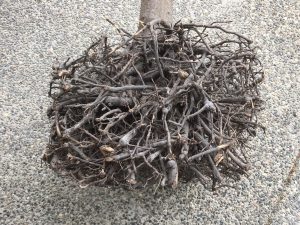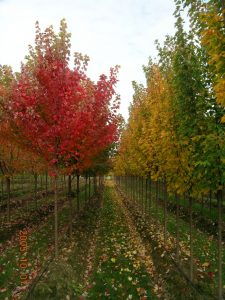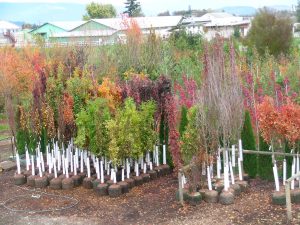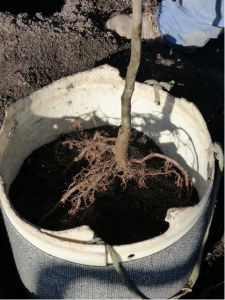Healthier root systems are in the (grow) bag: a nurseryman’s perspective
by Jim Barborinas
Urban Forestry Services, Inc.
TREE Fund Trustee
“How do the roots look?” I asked our crew again, a question I have been asking our nursery staff year after year. Because we grow landscape trees in fabric grow bags, it presents an opportunity to see how tree roots respond to this rather unique production method. Imagine tree roots growing through a container full of small holes in the ground, and now you understand the grow bag method of production in a nutshell. More specifically, tree liners are planted in the ground in geotextile fabric bags of different sizes, depending on species and harvest expectations. When dug, small roots are shaved off outside the bag, producing an abundance of roots inside a soil ball for transplanting.
The sales pitch for grow bags is that no circling roots are produced. In most cases, this is true. However, after utilizing grow bags for several years, I have found a couple of exceptions. Some species roots do not perform as planned in them, and delayed harvesting can also present a problem.
Anecdotally, we find species like elms, hawthorns, hornbeams, and styrax perfectly penetrate the fabric. This restricts larger roots from growing outside the bag, and forces more root branching inside; all of which are perfect root responses for future successful transplanting – the ideal root ball!
And then, there are the maples, ash, and cherries with fast growing aggressive roots, that if left in bags long enough, may grow too massive to penetrate the fabric; and therefore, begin to circle. This is cause for concern and drives the need for variety-specific production changes.
Ok, so why mess with grow bags in the first place? There are actually many reasons. On most species, they work as advertised, developing a concentration of thousands of root tips in a smaller than expected package. They are also available nearly year round, with higher transplant success for especially difficult to transplant species. Smaller equipment is needed to harvest, ship, move onsite, and plant the product than conventional B&B produced trees; and less soil is shipped away as well. All of these positive attributes are increasingly important as we strive for sustainability across the industry.
Every production method has its challenges, and grow bags are no exception; however, I am convinced that grow bags are an exceptional production method, and that the relatively few bugs can be fixed. After years of asking, “How do the roots look?” I have found that the roots are as variable as the tree species above ground. Some are fibrous, some very woody, others fleshy and thick, most with horizontal or vertical inclinations, and many so tiny, they are nearly invisible, or in some cases hardly there.

- In most cases, new root growth in grow bags penetrate the fabric but are restricted thereby producing larger and more concentrated roots in the root ball. However, some aggressive species like maples and plane trees begin to circle, with the use of some fabrics. Research is needed to match variable tree root growth with the right type of fabric.
Fabric used in grow bags can also be variable. We have actually seen altered root responses when using a different fabric by accident and/or due to an unknown product change. However, we still do not know enough about roots and their response to various production methods, such as a change of fabric used in a grow bag. Additional research and knowledge across the industry could increase our root response and transplanting success.
This further research needed in the area of grow bags is just one of the many reasons why Annie and I strongly support the TREE Fund. Riding in the first Tour de Trees nearly 24 years ago, I saw the most dedicated people in our industry act on a dream of building a funding source, and eventually an endowment, to fund important tree research. As the first TREE Fund Liaison for our PNW chapter, and as a two-time TREE Fund board member, I have seen this organization grow, and now flourish, to become the preeminent tree research funding source in our industry.
Witnessing new board members joining from the upper echelons of our industry, now giving time and direction to the TREE Fund, I am convinced that this is just the beginning, and we are on our way to much bigger dreams!
Annie and I are proud to have our family name attached to one of several endowment funds now at the TREE Fund. These funds focus on one or more tree industry challenges and support the TREE Fund’s mission to “Sustain the world’s urban forests by providing funding for scientific research, education programs, and scholarships related to arboriculture and urban forestry”. Once fully funded, our “Tree Root Research Barborinas Fund” can help to tackle issues similar to what we have experienced at our own nursery; and improve an already good production method into one of the best.
Every time you bid at a TREE Fund auction, buy a raffle ticket, support a Tour rider or provide an auction item you’re helping to fund solutions to the challenges we face. The more answers we uncover, the better tree stewards we all become. The information we garner from unbiased research will make confident and credible experts of us all. Join us in directing the course of our industry. Donate today at www.treefund.org.
Thank you!




